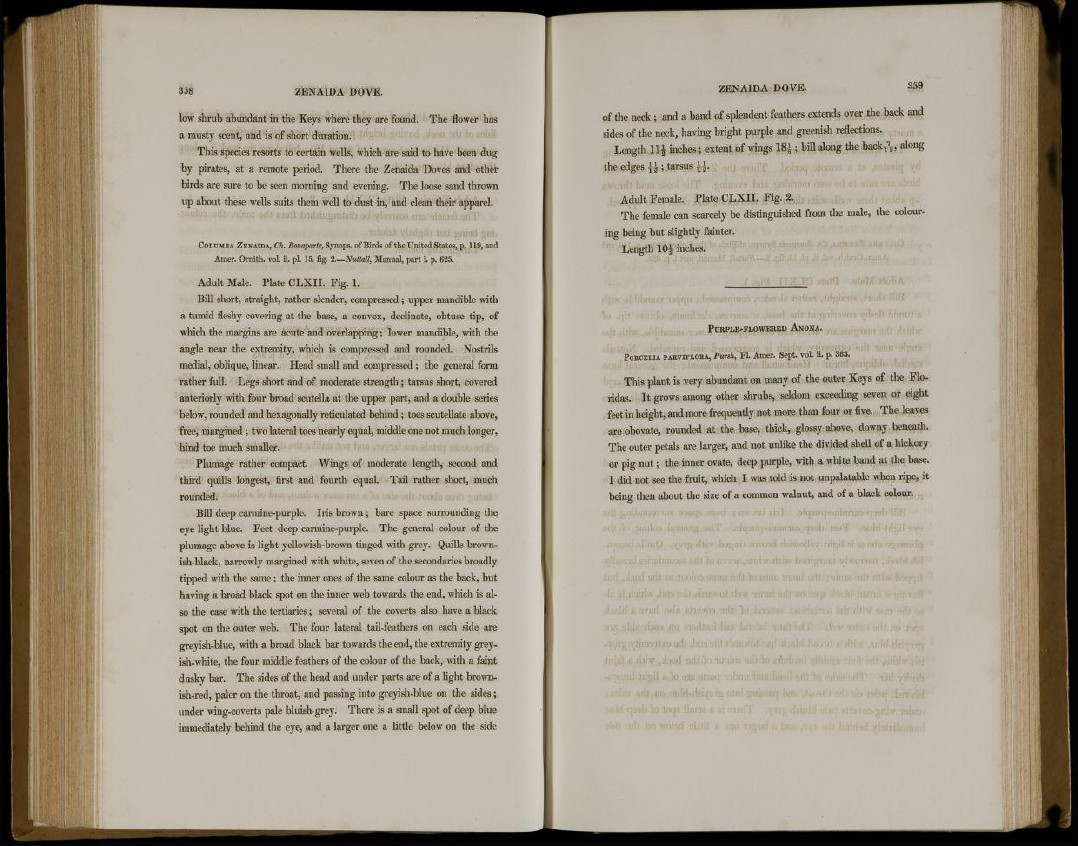
low shrub abundant in the Keys where they are found. The flower has
a musty scent, and is of short duration.
This species resorts to certain wells, which are said to have been dug
by pirates, at a remote period. There the Zenaida Doves and other
birds are sure to be seen morning and evening. The loose sand thrown
up about these wells suits them well to dust in, and clean their apparel.
•
COLUMBA ZENAIDA, Ch. Bonaparte, Synops. of Birds of the United States, p. 119, and
Amer. Ornith. voL ii. pi. 15. fig. 2—Nuttall, Manual, part i. p. 625.
Adult Male. Plate CLXII. Fig. 1.
Bill short, straight, rather slender, compressed; upper mandible with
a tumid fleshy covering at the base, a convex, declinate, obtuse tip, of
which the margins are acute and overlapping; lower mandible, with the
angle near the extremity, which is compressed and rounded. Nostrils
medial, oblique, linear. Head small and compressed ; the general form
rather full. Legs short and of moderate strength; tarsus short, covered
anteriorly with four broad scutella at the upper part, and a double series
below, rounded and hexagonally reticulated behind ; toes scutellate above,
free, margined ; two lateral toes nearly equal, middle one not much longer,
hind toe much smaller.
Plumage rather compact. Wings of moderate length, second and
third quills longest, first and fourth equal. Tail rather short, much
rounded.
Bill deep carmine-purple. Iris brown ; bare space surrounding the
eye light blue. Feet deep carmine-purple. The general colour of the
plumage above is light yellowish-brown tinged with grey. Quills brownish
black, narrowly margined with white, seven of the secondaries broadly
tipped with the same ; the inner ones of the same colour as the back, but
having a broad black spot on the inner web towards the end, which is also
the case with the tertiaries; several of the coverts also have a black
spot on the outer web. The four lateral tail-feathers on each side are
greyish-blue, with a broad black bar towards the end, the extremity greyish
white, the four middle feathers of the colour of the back, with a faint
dusky bar. The sides of the head and under parts are of a light brownish
red, paler on the throat, and passing into greyish-blue on the sides;
under wing-coverts pale bluish-grey. There is a small spot of deep blue
immediately behind the eye, and a larger one a little below on the side
of the neck ; and a band of splendent feathers extends over the back and
sides of the neck, having bright purple and greenish reflections.
Length 11£ inches ; extent of wings 18£ ; bill along the backT
7
2 , along
the edges \ \ ; tarsus
Adult Female. Plate CLXII. Fig. 2.
The female can scarcely be distinguished from the male, the colouring
being but slightly fainter.
Length 10£ inches.
PURPLE-FLOWERED ANONA.
PORCELIA PARVIFLORA, Pursh, Fl. Amer. Sept. vol. ii. p. 383.
This plant is very abundant on many of the outer Keys of the Floridas.
It grows among other shrubs, seldom exceeding seven or eight
feet in height, and more frequently not more than four or five. The leaves
are obovate, rounded at the base, thick, glossy above, downy beneath.
The outer petals are larger, and not unlike the divided shell of a hickory
or pig nut; the inner ovate, deep purple, with a white band at the base.
I did not see the fruit, which I was told is not unpalatable when ripe, it
being then about the size of a common walnut, and of a black colour.